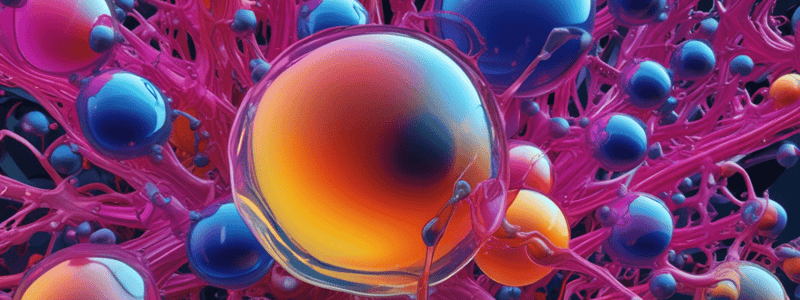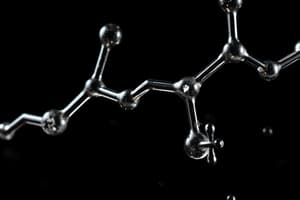Podcast
Questions and Answers
Which type of hydrocarbons have one or more triple bonds between carbon atoms?
Which type of hydrocarbons have one or more triple bonds between carbon atoms?
- Alkenes
- Alkanes
- Alkynes (correct)
- Alcohols
What is the general molecular formula of alkynes?
What is the general molecular formula of alkynes?
- $C_nH_{2n+2}$
- $C_nH_{2n}$
- $C_nH_{2n-4}$
- $C_nH_{2n-2}$ (correct)
Where is the triple bond located in a terminal alkyne?
Where is the triple bond located in a terminal alkyne?
- In the middle of the carbon chain
- At the end of the carbon chain (correct)
- At the beginning of the carbon chain
- Between two carbon atoms
What is the hybridization of each carbon in an alkyne?
What is the hybridization of each carbon in an alkyne?
How many degrees of unsaturation does a triple bond introduce in an alkyne?
How many degrees of unsaturation does a triple bond introduce in an alkyne?
What suffix is used in the IUPAC system to name alkynes?
What suffix is used in the IUPAC system to name alkynes?
What type of reaction is used to prepare alkynes from vicinal dihalides?
What type of reaction is used to prepare alkynes from vicinal dihalides?
How are geminal dihalides defined?
How are geminal dihalides defined?
What is the key feature that allows alkynes to undergo various reactions?
What is the key feature that allows alkynes to undergo various reactions?
In the context of alkynes, what does 'terminal alkynes' refer to?
In the context of alkynes, what does 'terminal alkynes' refer to?
Why are sp hybridized C−H bonds in terminal alkynes considered more acidic?
Why are sp hybridized C−H bonds in terminal alkynes considered more acidic?
In alkynes, which type of reaction is responsible for forming products with four new bonds?
In alkynes, which type of reaction is responsible for forming products with four new bonds?
What is the IUPAC name of the simplest alkyne, H-C≡C-H?
What is the IUPAC name of the simplest alkyne, H-C≡C-H?
What is the name given to a two-carbon alkyl group derived from acetylene?
What is the name given to a two-carbon alkyl group derived from acetylene?
What are compounds with both a double and triple bond named as?
What are compounds with both a double and triple bond named as?
Which of the following statements about the physical properties of alkynes is true?
Which of the following statements about the physical properties of alkynes is true?
What product is formed when acetylene burns in oxygen?
What product is formed when acetylene burns in oxygen?
What is acetylene commonly used for due to its very hot flame when combined with oxygen?
What is acetylene commonly used for due to its very hot flame when combined with oxygen?
What is the resulting ion when a terminal alkyne is deprotonated with a strong base?
What is the resulting ion when a terminal alkyne is deprotonated with a strong base?
What type of reaction do alkynes undergo when reacting with electrophiles?
What type of reaction do alkynes undergo when reacting with electrophiles?
In hydrohalogenation of alkynes, what does the addition of one mole of HX typically form?
In hydrohalogenation of alkynes, what does the addition of one mole of HX typically form?
What is the Brønsted-Lowry acid-base reaction product when a terminal alkyne is deprotonated by a strong base?
What is the Brønsted-Lowry acid-base reaction product when a terminal alkyne is deprotonated by a strong base?
Which rule governs the hydrohalogenation of alkynes, leading to the formation of geminal dihalides?
Which rule governs the hydrohalogenation of alkynes, leading to the formation of geminal dihalides?
Alkynes can react with electrophiles through three addition reactions.
Alkynes can react with electrophiles through three addition reactions.
In hydrohalogenation of alkynes, the addition of one mole of HX typically forms a geminal dihalide directly.
In hydrohalogenation of alkynes, the addition of one mole of HX typically forms a geminal dihalide directly.
Hydrohalogenation of alkynes follows Markovnikov's rule.
Hydrohalogenation of alkynes follows Markovnikov's rule.
A terminal alkyne can be deprotonated by a strong base in a Lewis acid-base reaction.
A terminal alkyne can be deprotonated by a strong base in a Lewis acid-base reaction.
Geminal dihalides are defined as having halogens attached to adjacent carbon atoms.
Geminal dihalides are defined as having halogens attached to adjacent carbon atoms.
Alkynes have the ability to form products with four new bonds due to their double bond.
Alkynes have the ability to form products with four new bonds due to their double bond.
Sp hybridized C−H bonds in terminal alkynes are considered less acidic compared to other hybridizations.
Sp hybridized C−H bonds in terminal alkynes are considered less acidic compared to other hybridizations.
Acetylene is commonly used for its very cold flame when combined with oxygen.
Acetylene is commonly used for its very cold flame when combined with oxygen.
Compounds with both a double and triple bond are named as alkadienes.
Compounds with both a double and triple bond are named as alkadienes.
The hydrohalogenation of alkynes leads to the formation of geminal dihalides following Markovnikov's rule.
The hydrohalogenation of alkynes leads to the formation of geminal dihalides following Markovnikov's rule.
Flashcards are hidden until you start studying




